The beautiful New England state of Massachusetts has 16 national parks, as well as several other state parks and wildlife refuges. The state is also home to a variety of wildlife, like black bears, colorful birds, marine animals, and at least 14 different species of snakes. Only two of these types of snakes are venomous, however, including the timber rattlesnake. Let’s take a closer look at Massachusetts’s only rattlesnake species!
Timber Rattlesnake
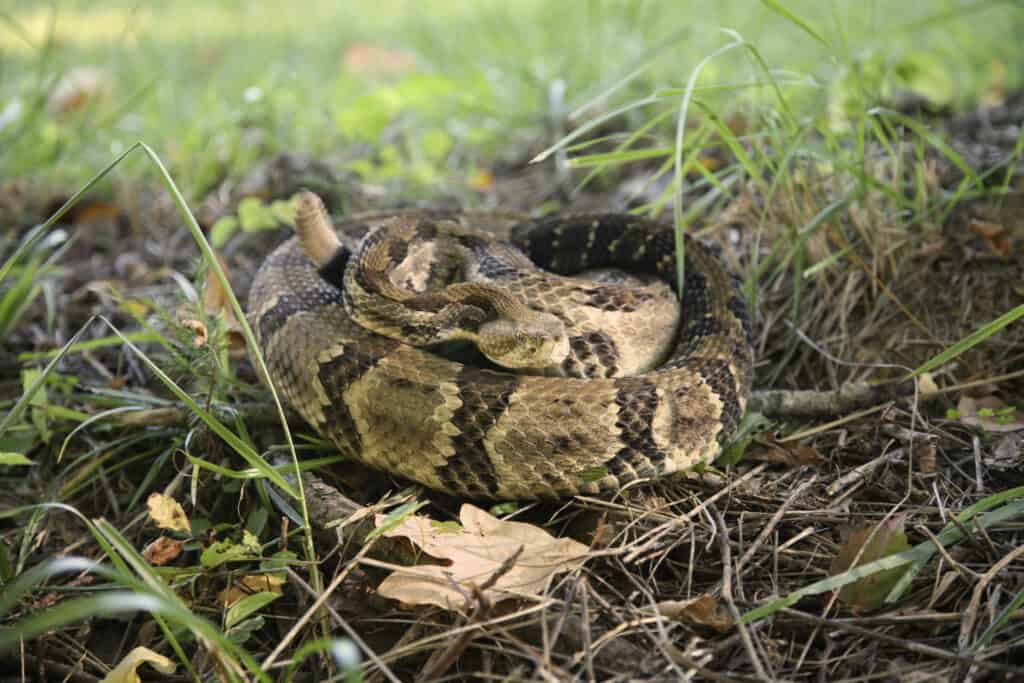
The timber rattlesnake is extremely venomous, but not typically aggressive.
©iStock.com/NajaShots
| Timber Rattlesnake | |
|---|---|
| Range | Boston area, Connecticut River Valley, Berkshire County |
| Length | 36-60 inches |
Timber rattlesnakes almost exclusively live in mountainous areas with forests, rocky ledges, and lots of rodents. In Massachusetts timber rattlesnakes hibernate or brumate through the winter in underground crevices or burrows. They are active beginning in mid-April, but for the first few weeks they are usually sluggish, often basking in the sun on rocky ledges. During the summer they often hide during the heat of the day and hunt at night. As the weather turns cold in mid-October, they return once again to their hibernating dens.
Although the timber rattlesnake is a highly venomous pit viper, this snake is extremely rare in Massachusetts. Timber rattlesnakes once lived all over the state, but today there are only five populations left in the Boston area, Connecticut River Valley, and Berkshire County. In fact, the timber rattlesnake is one of the most endangered animals in Massachusetts and is protected by the Massachusetts Endangered Species Act (MESA). Some of the major threats to this rare rattlesnake are intentional harassment and killing, poachers, and vehicle mortality, along with habitat destruction and natural health concerns.
If you are lucky enough to come across a timber rattlesnake in Massachusetts, be sure to leave it alone. Remember, these snakes can be dangerous, and they are protected by state laws in Massachusetts. That means that it is illegal to possess, harass, kill, or otherwise endanger these snakes. However, since they are rare and in need of conservation, you can take a photo of the snake (from a safe distance of course) and send it and its location to [email protected].
How Dangerous Are Timber Rattlesnakes?
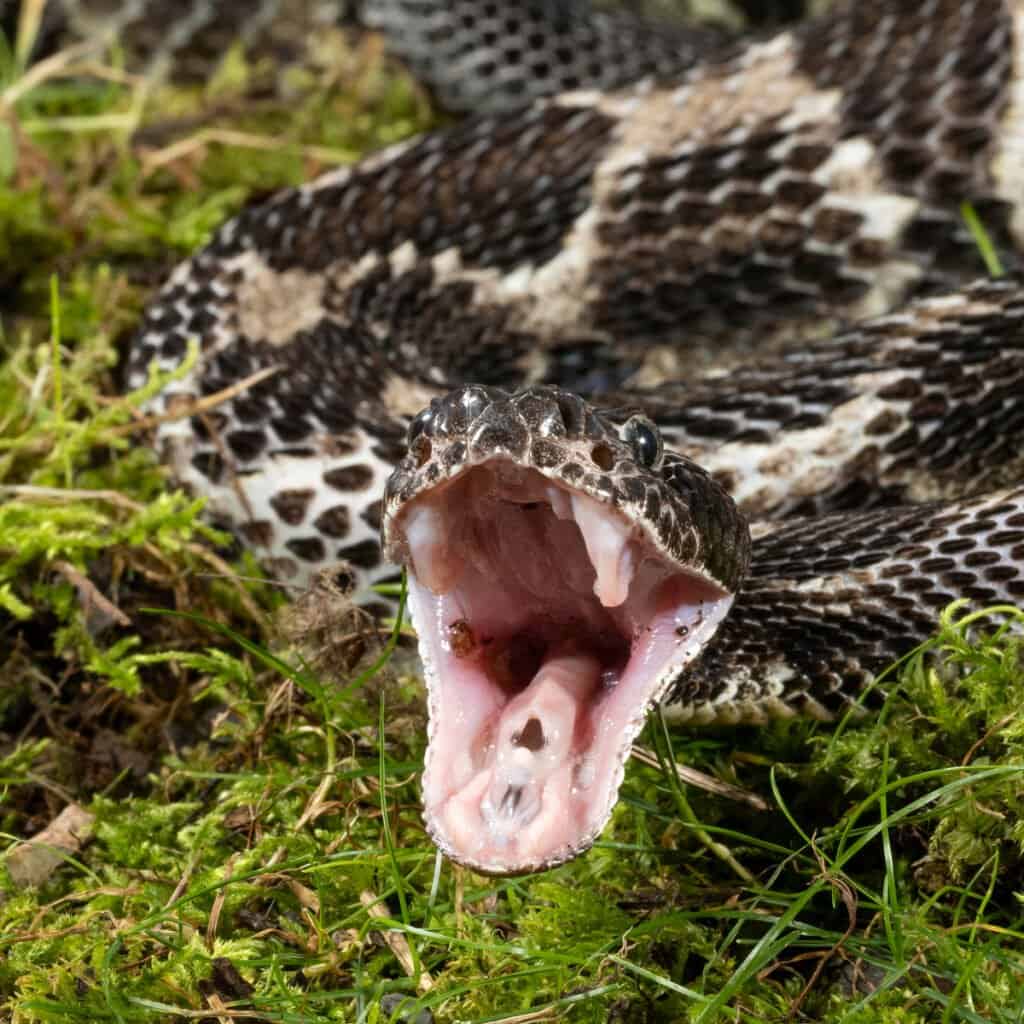
Despite being venomous, timber rattlesnakes do not readily strike without reason
©Joe McDonald/Shutterstock.com
It is true that timber rattlesnakes are some of the most venomous snakes in the United States, but they are not quite as dangerous as you might imagine. These snakes are shy and timid, and do not readily strike, even when threatened.
In fact, timber rattlesnakes much prefer to slither away from danger when possible, and usually only bite if they feel trapped or if you touch or try to handle them. Even then they often do not use the full force of their powerful venom. Timber rattlesnakes typically only strike when they are accidentally stepped on. In fact, the last death in Massachusetts caused by a timber rattlesnake bite occurred back in 1791!
What Do Timber Rattlesnakes Look Like?
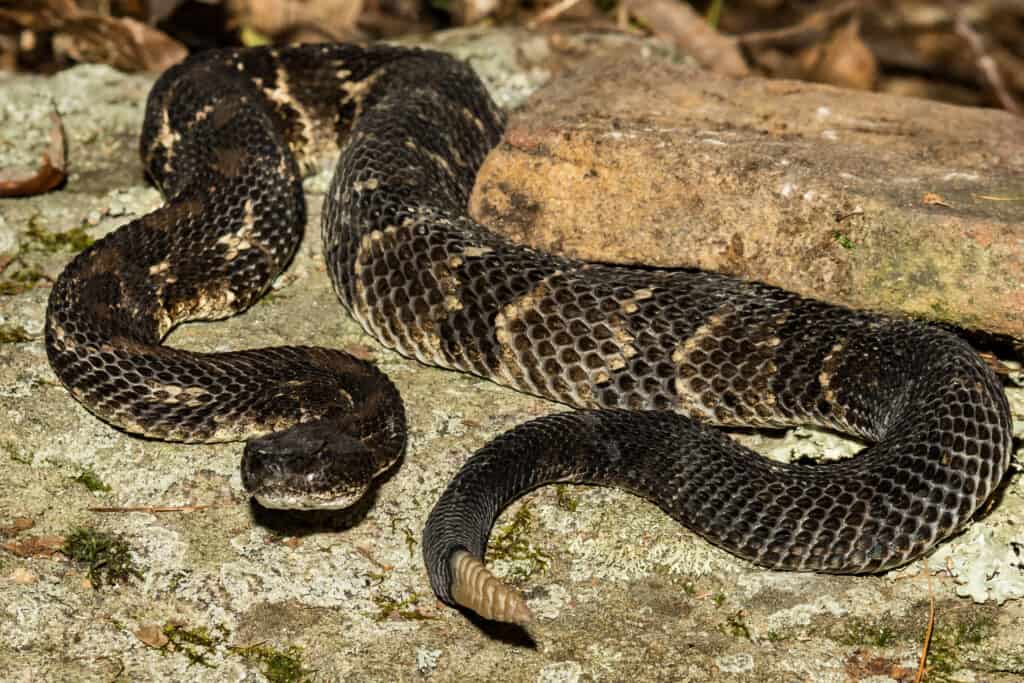
Black phase Timber Rattlesnakes have dark speckles all over their bodies that make them look much darker.
©iStock.com/JasonOndreicka
Timber Rattlesnakes are quite large snakes and have dense, heavy bodies. They usually grow between 36-60 inches in length, and weigh between 1.3-2 pounds on average. Like all pit vipers, timber rattlesnakes have large, triangular shaped heads with thin, distinct necks. There are also two heat-sensing “pits” between their eyes and nostrils.
Most of the time you can identify a timber rattlesnake in Massachusetts quickly by looking at the snake’s tail. Like all rattlesnakes, timber rattlesnakes have keratin segments at the tip of their tails, forming a large rattle. When the snakes vibrate their tails, the segments hit together, making a loud rattling sound. However, baby rattlesnakes are born with just one keratin button. Each time the snake sheds, another segment is added, eventually forming the rattle. These rattles can also be fragile, and sometimes pieces break off when the snake sheds as well.
There are several different colors and phases of timber rattlesnakes in Massachusetts. Some snakes are yellow or a greyish yellow color, while others may appear almost entirely black. There are rust, brown, or black blotches and crossbands along their backs and sides, and no markings on the head or face. Timber rattlesnakes also have black tipped tails, just before their rattle, and the scales along their bodies are keeled with ridges in the middle of each scale.
Similar Species in Massachusetts
There are a few other snake species in Massachusetts that you might confuse for a timber rattlesnake. However, these snakes are nonvenomous, and most are harmless to humans. Here are a few examples.
Northern Water Snake
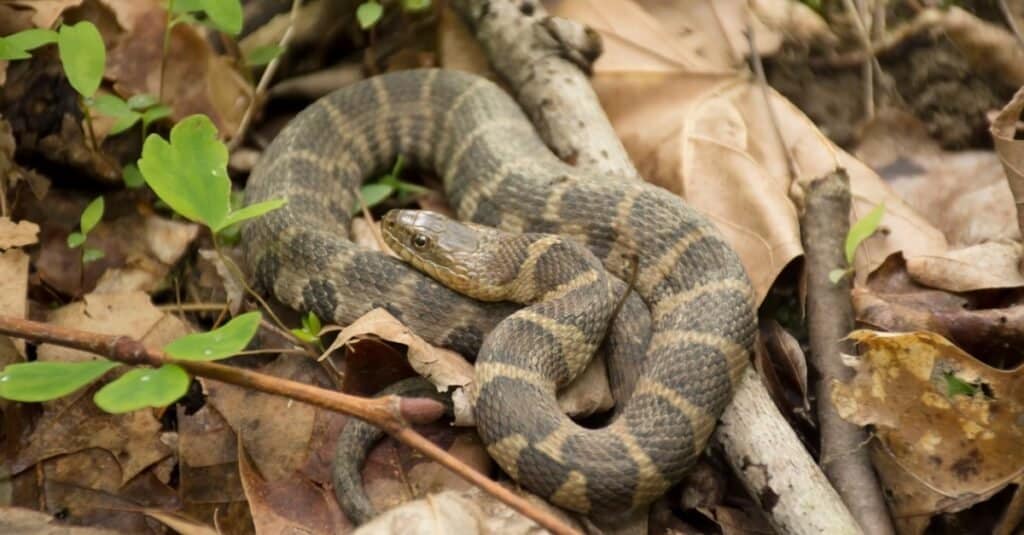
The northern water snake has a large, thick body
©iStock.com/IcemanJ
| Northern Water Snake | |
|---|---|
| Range | In and near bodies of water and wetlands. |
| Length | 24-55 inches |
Like timber rattlesnakes, northern water snakes also have large, heavy bodies, although they are usually not quite as thick. They are often brown, gray, or black, with crossbands, saddles, or blotches along their backs, and grow up to 55 inches long with highly keeled scales. Water snakes live in wetland areas, and you might even see one of these snakes swimming along through the water as it hunts for fish and amphibians.
Eastern Milk Snake
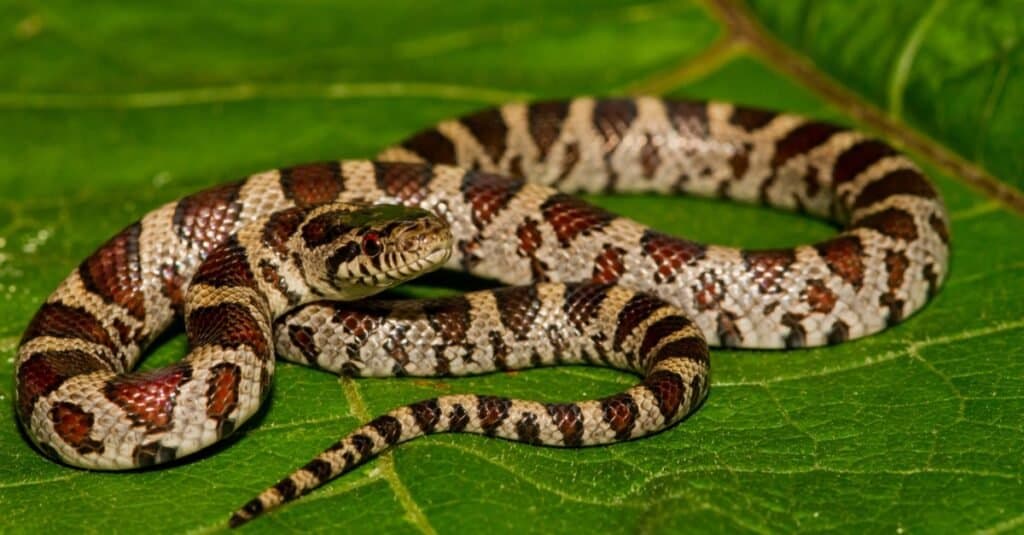
The eastern milk snake is not venomous and preys mainly on small rodents
©Jay Ondreicka/Shutterstock.com
| Eastern Milk Snake | |
|---|---|
| Range | All of Massachusetts |
| Length | 24-36 inches |
While the nonvenomous eastern milk snake may have a few similarities with the timber rattlesnake, there are many differences to look for. Eastern milk snakes, for example, have smooth rather than keeled scales, narrower heads, and no rattles. Their bodies are reddish, gray, or brown, with mottled patterns and black-bordered blotches on their backs and sides. They usually do not grow as long as a timber rattlesnake either, averaging 24-36 inches in length. These snakes live all over Massachusetts on rocky hillsides, woodlands, fields, and along the edges of wetlands.
Eastern Hognose Snake
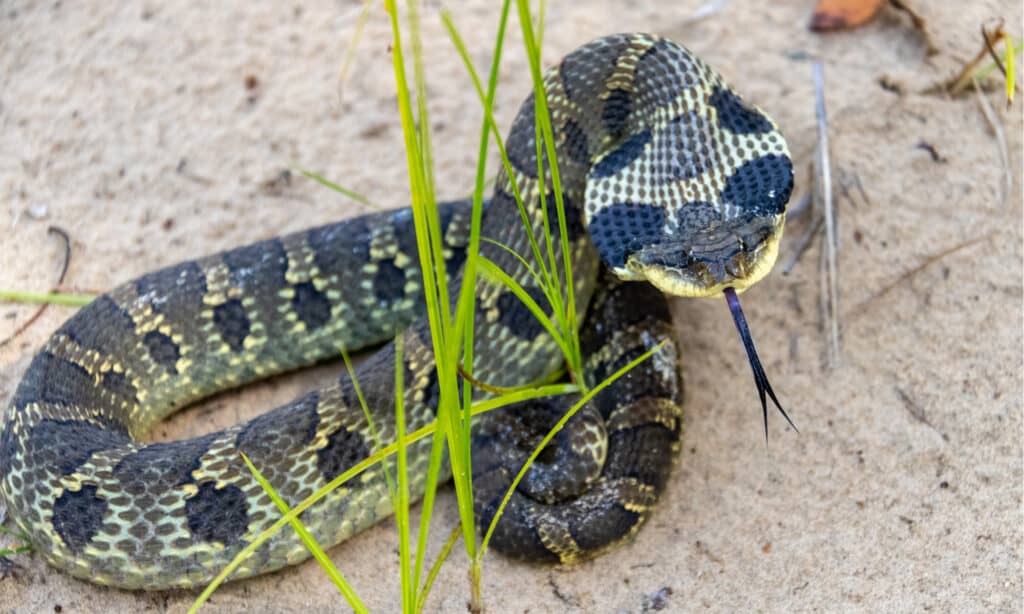
The Eastern Hognose Snake often acts like venomous ones when threatened
©IHX/Shutterstock.com
| Eastern Hognose Snake | |
|---|---|
| Range | Eastern 2/3 of Massachusetts |
| Length | 28-46 inches |
One of the most interesting looking snakes in Massachusetts is the eastern hognose snake. These snakes come in a wide variety of different colors and patterns, and often have distinct blotches that look similar to the timber rattlesnake. However, eastern hognose snakes are often smaller, growing 28-46 inches long.
Eastern hognose snakes typically only live in the eastern 2/3 of Massachusetts, although they are rarely encountered. They are a Species of Special Concern in the state and are harmless to humans. When they feel threatened, they put on quite the display, however, rising and hissing loudly. Their unusually wide necks can stretch out like a cobra, and they may vibrate the tips of their tails like a rattlesnake. Sometimes they even strike with their mouths closed as a warning. Some snakes take a different approach, however, and dramatically play dead when they feel threatened.
Up Next:
- The 10 Best Lakes in Massachusetts: Boating, Camping, Swimming, and More!
- Discover the 10 Largest Animals in Massachusetts and Where You’ll Find Them
- 5 of the Biggest Spiders in Massachusetts
- The 5 Best Places to Camp in Massachusetts this Summer
The photo featured at the top of this post is © Joe McDonald/Shutterstock.com
Discover the "Monster" Snake 5X Bigger than an Anaconda
Every day A-Z Animals sends out some of the most incredible facts in the world from our free newsletter. Want to discover the 10 most beautiful snakes in the world, a "snake island" where you're never more than 3 feet from danger, or a "monster" snake 5X larger than an anaconda? Then sign up right now and you'll start receiving our daily newsletter absolutely free.
Sources
- Massachusetts State gov, Available here: https://www.mass.gov/service-details/rattlesnake-conservation-in-massachusetts
- Massachusetts State gov, Available here: https://www.mass.gov/doc/timber-rattlesnake-factsheet/download
- Massachusetts State gov, Available here: https://www.mass.gov/doc/living-with-wildlife-timber-rattlesnakes-in-massachusetts/download
- Mass Audubon, Available here: https://www.massaudubon.org/learn/nature-wildlife/reptiles-amphibians/snakes/snake-species-in-massachusetts
Thank you for reading! Have some feedback for us? Contact the AZ Animals editorial team.






